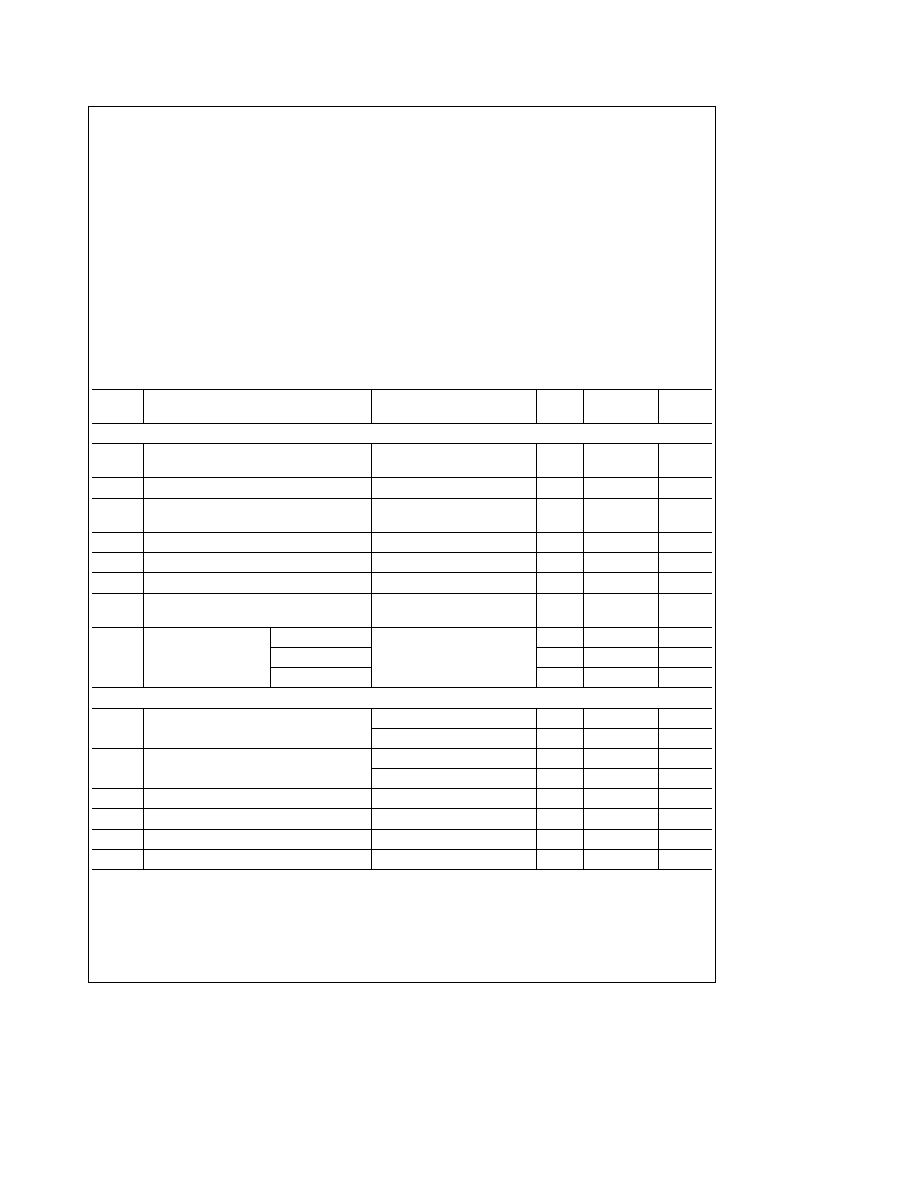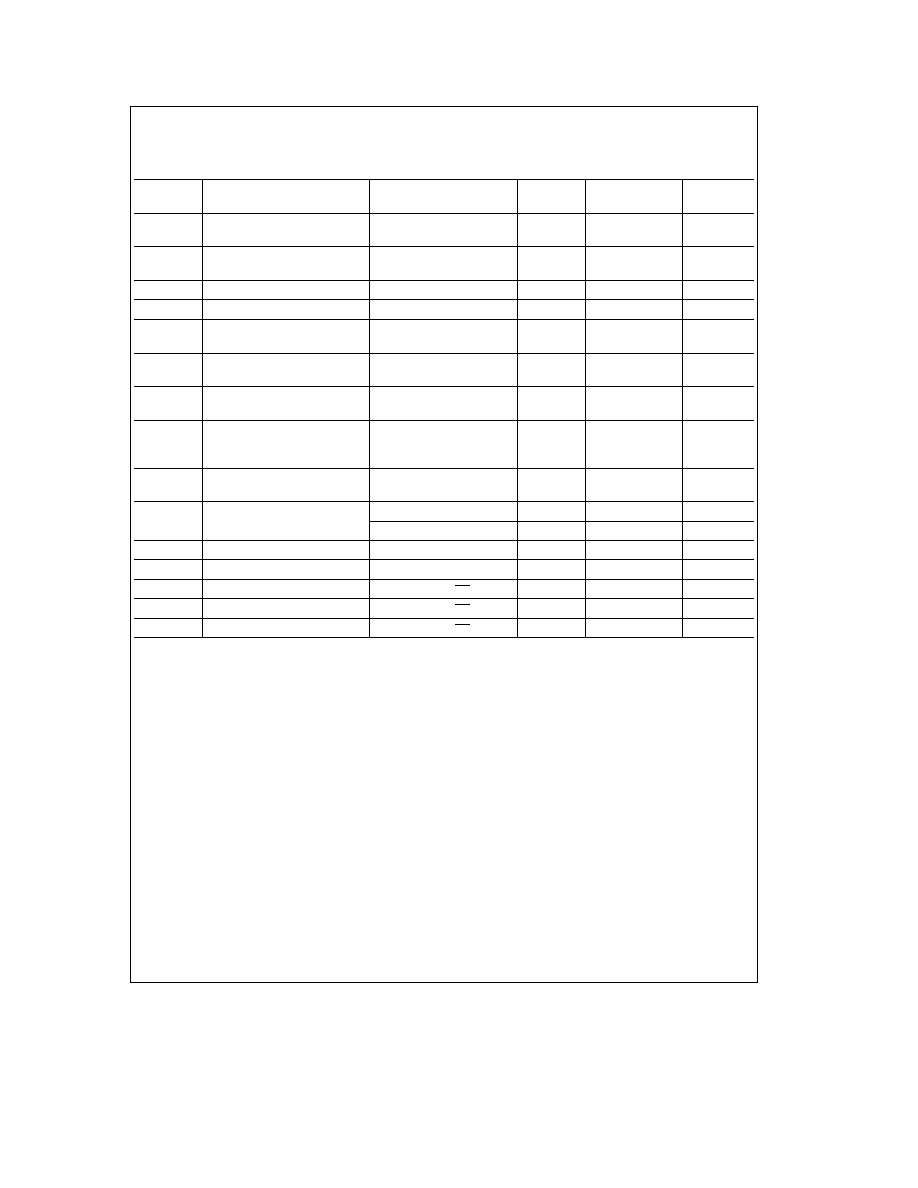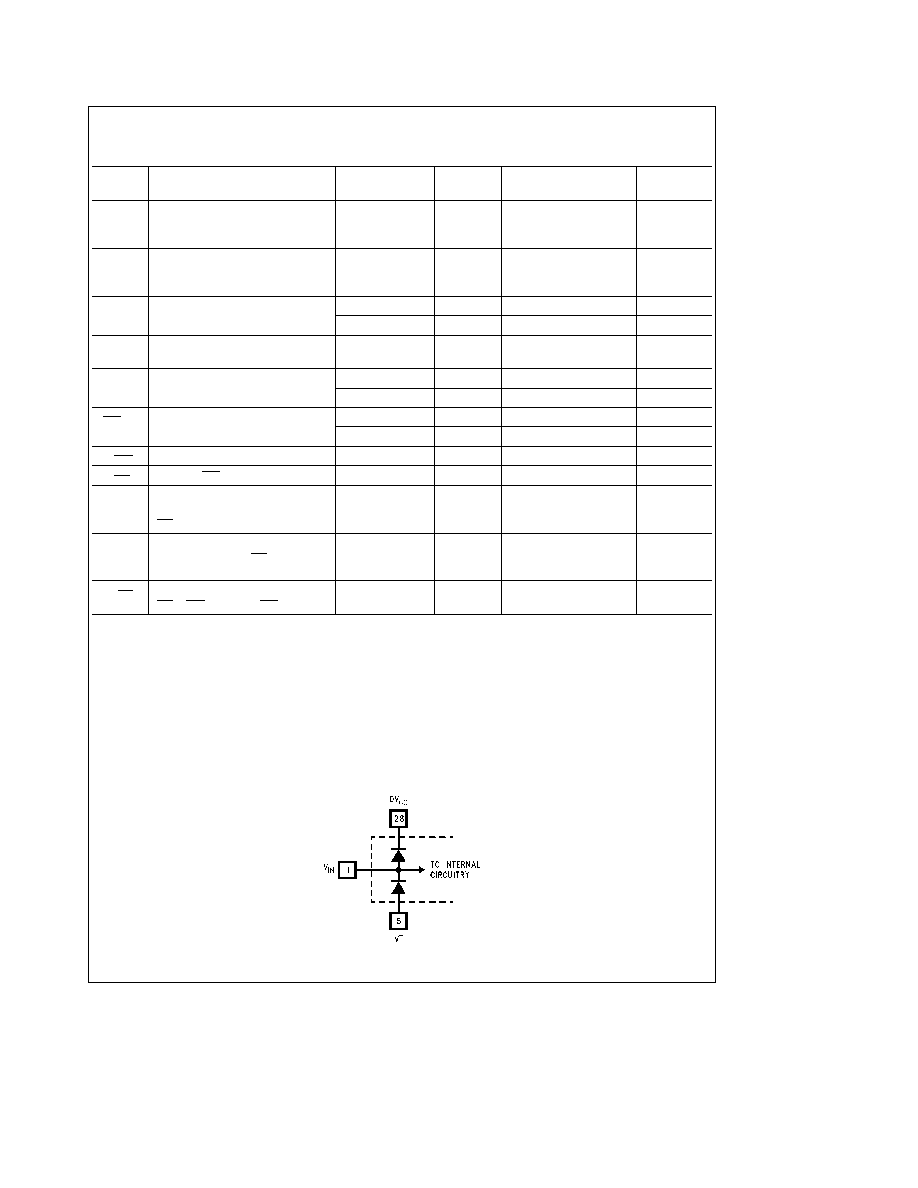 | –≠–ª–µ–∫—Ç—Ä–æ–Ω–Ω—ã–π –∫–æ–º–ø–æ–Ω–µ–Ω—Ç: ADC1242 | –°–∫–∞—á–∞—Ç—å:  PDF PDF  ZIP ZIP |

TL H 11735
ADC1242
12-Bit
Plus
Sign
Sampling
AD
Converter
February 1995
ADC1242
12-Bit Plus Sign Sampling A D Converter
General Description
The ADC1242 is a CMOS 12-bit plus sign successive ap-
proximation analog-to-digital converter
On request
the
ADC1242 goes through a self-calibration cycle that adjusts
positive linearity error to less than
g
1 LSB full-scale error to
less than
g
3 LSB and zero error to less than
g
2 LSB The
ADC1242 also has the ability to go through an Auto-Zero
cycle that corrects the zero error during every conversion
The analog input to the ADC1242 is tracked and held by the
internal circuitry and therefore does not require an external
sample-and-hold A unipolar analog input voltage range (0V
to
a
5V) or a bipolar range (
b
5V to
a
5V) can be accom-
modated with
g
5V supplies
The 13-bit word on the outputs of the ADC1242 gives a 2's
complement representation of negative numbers The digi-
tal inputs and outputs are compatible with TTL or CMOS
logic levels
Applications
Y
Digital Signal Processing
Y
High Resolution Process Control
Y
Instrumentation
Key Specifications
Y
Resolution
12 Bits plus Sign
Y
Conversion Time
13 8 ms (max)
Y
Linearity Error
g
1 LSB (
g
0 0244%) (max)
Y
Zero Error
g
2 LSB (max)
Y
Positive Full Scale Error
g
3 LSB (max)
Y
Power Consumption
70 mW (max)
Features
Y
Self-calibrating
Y
Internal sample-and-hold
Y
Bipolar input range with
g
5V supplies and single
a
5V reference
Y
No missing codes over temperature
Y
TTL MOS input output compatible
Y
Standard 28-pin ceramic DIP
TRI-STATE
is a registered trademark of National Semiconductor Corporation
Simplified Schematic
TL H 11735 ≠ 1
Connection Diagram
Dual-In-Line Package
TL H 11735 ≠ 2
Top View
Order Number ADC1242CIJ
See NS Package Number J28A
C1995 National Semiconductor Corporation
RRD-B30M115 Printed in U S A

Absolute Maximum Ratings
(Notes 1
2)
If Military Aerospace specified devices are required
please contact the National Semiconductor Sales
Office Distributors for availability and specifications
Supply Voltage (V
CC
e
DV
CC
e
AV
CC
)
6 5V
Negative Supply Voltage (V
b
)
b
6 5V
Voltage at Logic Control Inputs
b
0 3V to (V
CC
a
0 3V)
Voltage at Analog Input (V
IN
)
(V
b
b
0 3V) to (V
CC
a
0 3V)
AV
CC
-DV
CC
(Note 7)
0 3V
Input Current at any Pin (Note 3)
g
5 mA
Package Input Current (Note 3)
g
20 mA
Power Dissipation at 25 C (Note 4)
875 mW
Storage Temperature Range
b
65 C to
a
150 C
ESD Susceptability (Note 5)
2000V
Soldering Information
J Package (10 seconds)
300 C
Operating Ratings
(Notes 1 and 2)
Temperature Range
T
MIN
s
T
A
s
T
MAX
ADC1242CIJ
b
40 C
s
T
A
s
a
85 C
DV
CC
and AV
CC
Voltage
(Notes 6 and 7)
4 5V to 5 5V
Negative Supply Voltage (V
b
)
b
4 5V to
b
5 5V
Reference Voltage
(V
REF
Notes 6 and 7)
3 5V to AV
CC
a
50 mV
Converter Electrical Characteristics
The following specifications apply for V
CC
e
DV
CC
e
AV
CC
e a
5 0V V
b
e b
5 0V V
REF
e a
4 096V and f
CLK
e
2 0 MHz
unless otherwise specified Boldface limits apply for T
A
e
T
J
e
T
MIN
to T
MAX
all other limits T
A
e
T
J
e
25 C (Notes
6 7 and 8)
Symbol
Parameter
Conditions
Typical
Limit
Units
(Note 9) (Notes 10 18)
(Limit)
STATIC CHARACTERISTICS
Positive Integral
After Auto-Cal
g
1
LSB(max)
Linearity Error
(Notes 11 and 12)
Differential Linearity
After Auto-Cal (Notes 11 and 12)
12
Bits(min)
Zero Error
After Auto-Zero or Auto-Cal
g
2
LSB(max)
(Notes 12 and 13)
Positive and Negative Full-Scale Error
After Auto-Cal (Note 12)
g
3
LSB(max)
C
REF
V
REF
Input Capacitance
80
pF
C
IN
Analog Input Capacitance
65
pF
V
IN
Analog Input Voltage
V
b
b
0 05
V(min)
V
CC
a
0 05
V(max)
Power Supply
Zero Error (Note 14) AV
CC
e
DV
CC
e
5V
g
5%
g
LSB
Sensitivity
Full-Scale Error
V
REF
e
4 75V V
b
e b
5V
g
5%
g
LSB
Linearity Error
g
LSB
DYNAMIC CHARACTERISTICS
S (N
a
D) Unipolar Signal-to-Noise
a
Distortion
f
IN
e
1 kHz V
IN
e
4 85 V
p-p
72
dB
Ratio (Note 17)
f
IN
e
10 kHz V
IN
e
4 85 V
p-p
72
dB
S (N
a
D) Bipolar Signal-to-Noise
a
Distortion
f
IN
e
1 kHz V
IN
e
g
4 85 V
p-p
76
dB
Ratio (Note 17)
f
IN
e
10 kHz V
IN
e
g
4 85 V
p-p
76
dB
Unipolar Full Power Bandwidth (Note 17)
V
IN
e
0V to 4 85V
32
kHz
Bipolar Full Power Bandwidth (Note 17)
V
IN
e
g
4 85 V
p-p
25
kHz
t
Ap
Aperture Time
100
ns
Aperture Jitter
100
ps
rms
2

Digital and DC Electrical Characteristics
The following specifications apply for V
CC
e
DV
CC
e
AV
CC
e a
5 0V V
b
e b
5 0V V
REF
e a
4 096V and f
CLK
e
2 0 MHz
unless otherwise specified Boldface limits apply for T
A
e
T
J
e
T
MIN
to T
MAX
all other limits T
A
e
T
J
e
25 C
(Notes 6 and 7)
Symbol
Parameter
Condition
Typical
Limit
Units
(Note 9)
(Notes 10 18)
(Limits)
V
IN(1)
Logical ``1'' Input Voltage for
V
CC
e
5 25V
2 0
V(min)
All Inputs except CLK IN
V
IN(0)
Logical ``0'' Input Voltage for
V
CC
e
4 75V
0 8
V(max)
All Inputs except CLK IN
I
IN(1)
Logical ``1'' Input Current
V
IN
e
5V
0 005
1
m
A(max)
I
IN(0)
Logical ``0'' Input Current
V
IN
e
0V
b
0 005
b
1
m
A(max)
V
T
a
CLK IN Positive-Going
2 8
2 7
V(min)
Threshold Voltage
V
T
b
CLK IN Negative-Going
2 1
2 3
V(max)
Threshold Voltage
V
H
CLK IN Hysteresis
0 7
0 4
V(min)
V
T
a
(min)
b
V
T
b
(max)
V
OUT(1)
Logical ``1'' Output Voltage
V
CC
e
4 75V
I
OUT
e b
360 mA
2 4
V(min)
I
OUT
e b
10 mA
4 5
V(min)
V
OUT(0)
Logical ``0'' Output Voltage
V
CC
e
4 75V
0 4
V(max)
I
OUT
e
1 6 mA
I
OUT
TRI-STATE Output Leakage
V
OUT
e
0V
b
0 01
b
3
m
A(max)
Current
V
OUT
e
5V
0 01
3
m
A(max)
I
SOURCE
Output Source Current
V
OUT
e
0V
b
20
b
6 0
mA(min)
I
SINK
Output Sink Current
V
OUT
e
5V
20
8 0
mA(min)
DI
CC
DV
CC
Supply Current
f
CLK
e
2 MHz CS
e
``1''
1
2
mA(max)
AI
CC
AV
CC
Supply Current
f
CLK
e
2 MHz CS
e
``1''
2 8
6
mA(max)
I
b
V
b
Supply Current
f
CLK
e
2 MHz CS
e
``1''
2 8
6
mA(max)
3

AC Electrical Characteristics
The following specifications apply for DV
CC
e
AV
CC
e
a
5 0V V
b
e
b
5 0V t
r
e
t
f
e
20 ns unless otherwise specified
Boldface limits apply for T
A
e
T
J
e
T
MIN
to T
MAX
all other limits T
A
e
T
J
e
25 C (Notes 6 and 7)
Symbol
Parameter
Conditions
Typical
Limit
Units
(Note 9)
(Notes 10 18)
(Limits)
f
CLK
Clock Frequency
2 0
MHz
0 5
MHz(min)
4 0
MHz(max)
Clock Duty Cycle
50
%
40
%(min)
60
%(max)
t
C
Conversion Time
27(1 f
CLK
)
27(1 f
CLK
)
a
300 ns
(max)
f
CLK
e
2 0 MHz
13 5
m
s
t
A
Acquisition Time
R
SOURCE
e
50X
7(1 f
CLK
)
7(1 f
CLK
)
a
300 ns
(max)
(Note 15)
f
CLK
e
2 0 MHz
3 5
m
s
t
Z
Auto Zero Time
26
26
1 f
CLK
(max)
f
CLK
e
2 0 MHz
13
m
s
t
CAL
Calibration Time
1396
1 f
CLK
f
CLK
e
2 0 MHz
698
706
m
s(max)
t
W(CAL)L
Calibration Pulse Width
(Note 16)
60
200
ns(min)
t
W(WR)L
Minimum WR Pulse Width
60
200
ns(min)
t
ACC
Maximum Access Time
C
L
e
100 pF
(Delay from Falling Edge of
50
85
ns(max)
RD to Output Data Valid)
t
0H
t
1H
TRI-STATE Control (Delay
R
L
e
1 kX
from Rising Edge of RD
C
L
e
100 pF
30
90
ns(max)
to Hi-Z State)
t
PD(INT)
Maximum Delay from Falling Edge of
100
175
ns(max)
RD or WR to Reset of INT
Note 1
Absolute Maximum Ratings indicate limits beyond which damage to the device may occur Operating Ratings indicate conditions for which the device is
functional but do not guarantee specific performance limits For guaranteed specifications and test conditions see the Electrical Characteristics The guaranteed
specifications apply only for the test conditions listed Some performance characteristics may degrade when the device is not operated under the listed test
conditions
Note 2
All voltages are measured with respect to AGND and DGND unless otherwise specified
Note 3
When the input voltage (V
IN
) at any pin exceeds the power supply rails (V
IN
k
V
b
or V
IN
l
(AV
CC
or DV
CC
) the current at that pin should be limited to
5 mA The 20 mA maximum package input current rating allows the voltage at any four pins with an input current limit of 5 mA to simultaneously exceed the power
supply voltages
Note 4
The maximum power dissipation must be derated at elevated temperatures and is dictated by T
JMAX
(maximum junction temperature) i
JA
(package
junction to ambient thermal resistance) and T
A
(ambient temperature) The maximum allowable power dissipation at any temperature is P
Dmax
e
(T
Jmax
b
T
A
) i
JA
or the number given in the Absolute Maximum Ratings whichever is lower For this device T
Jmax
e
125 C and the typical thermal resistance (i
JA
) of the
ADC1242 CIJ when board mounted is 47 C W
Note 5
Human body model 100 pF discharged through a 1 5 kX resistor
Note 6
Two on-chip diodes are tied to the analog input as shown below Errors in the A D conversion can occur if these diodes are forward biased more than
50 mV
TL H 11735 ≠ 3
This means that if AV
CC
and DV
CC
are minimum (4 75 V
DC
) and V
b
is maximum (
b
4 75 V
DC
) full-scale must be
s
4 8 V
DC
4

AC Electrical Characteristics
(Continued)
Note 7
A diode exists between AV
CC
and DV
CC
as shown below
TL H 11735 ≠ 4
To guarantee accuracy it is required that the AV
CC
and DV
CC
be connected together to a power supply with separate bypass filters at each V
CC
pin
Note 8
Accuracy is guaranteed at f
CLK
e
2 0 MHz At higher and lower clock frequencies accuracy may degrade See curves in the Typical Performance
Characteristics Section
Note 9
Typicals are at T
J
e
25 C and represent most likely parametric norm
Note 10
Limits are guaranteed to National's AOQL (Average Outgoing Quality Level)
Note 11
Positive linearity error is defined as the deviation of the analog value expressed in LSBs from the straight line that passes through positive full scale and
zero For negative linearity error the straight line passes through negative full scale and zero (See
Figures 1b and 1c )
Note 12
The ADC1242's self-calibration technique ensures linearity full scale and offset errors as specified but noise inherent in the self-calibration process will
result in a repeatability uncertainty of
g
0 20 LSB
Note 13
If T
A
changes then an Auto-Zero or Auto-Cal cycle will have to be re-started see the typical performance characteristic curves
Note 14
After an Auto-Zero or Auto-Cal cycle at the specified power supply extremes
Note 15
If the clock is asynchronous to the falling edge of WR an uncertainty of one clock period will exist in the interval of t
A
therefore making the minimum t
A
e
6 clock periods and the maximum t
A
e
7 clock periods If the falling edge of the clock is synchronous to the rising edge of WR then t
A
will be exactly 6 5 clock
periods
Note 16
The CAL line must be high before any other conversion is started
Note 17
The specifications for these parameters are valid after an Auto-Cal cycle has been completed
Note 18
A military RETS electrical test specification is available upon request At time of printing the ADC1241CMJ 883 RETS specification complies fully with the
boldface
limits in this column
TL H 11735 ≠ 5
FIGURE 1a Transfer Characteristic
5




